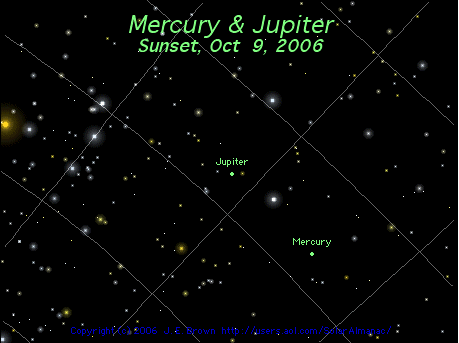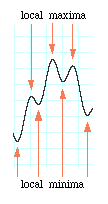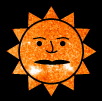- altitude
- angle. Angle above the observer's astronomical horizon. Equivalently, 90° minus the angle between an object and the observer's zenith. An object on the astronomical horizon has an altitude of 0°. An object midway between has an altitude of 45°. An object overhead has an altitude of 90°.
- aphelion
- event. The moment when any object is at its greatest distance from the Sun. Compare perihelion.
- apogee
- event. The moment when the Moon (or any other satellite in orbit around the Earth) is at its greatest distance from Earth's center. Compare perigee.
- astronomical horizon
- An ideal flat and level horizon, usually only found at sea. Sometimes called "the horizontal". A great circle surrounding the observer, 90° off of the zenith. The position of the astronomical horizon is independent of and not affected by any mountains or other obstructions visible from the observer's position. At The Solar Almanac, calculations of sunrise, sunset, moonrise, moonset, etc. ignore local obstructions and so are defined in terms of your astronomical horizon. Compare horizon.
- azimuth
- angle. A compass direction, expressed as an angle: 0° = North, 90° = East, 180° = South, 270° = West. 45° = Northeast, and so on.
In graphics at The Solar Almanac, the horizon is labeled with azimuth numbers and the compass points N, NE, E, SE, S, SW, W, and NW. [example graphic]
- brilliancy
- n. The brightness of an object, as seen by an observer. See also magnitude.
- celestial coordinates
- angles. The right ascension and declination of an object in the sky. Compare ecliptic coordinates.
- color codes
- Color codes indicate the lighting conditions in effect at the time of each event:
Sunlight: Events occurring in the daytime are shown on a white background.
Moonlight: Events occurring at night but under moonlight are shown on a dim blue background.
Starry Night: Events occurring at night with no Moon are shown on a black background.
- conjunction
- event. An ancient measure of closeness between two moving objects. Two objects are said to be in conjunction when they have the same ecliptic longitude. Note that the moment of conjunction is not necessarily the moment of least elongation.
- culmination
- event. The time and event when any object reaches its highest altitude (least zenith distance) for the day (or roughly a one-day period). As the Earth turns under the stars, each object in the heavens reaches a high point and low point above and below the observer, roughly daily; these events are called the upper and lower culminations of that object.
Highest Culmination: Here "highest" means "higher than yesterday's and also higher than tomorrow's". It is what mathematicians call a "local maximum": a high, but not necessarily a record high.
Lowest Upper Culmination: a lowest high. What mathematicians call a "local minimum". See Highest Culmination.
→ In The Solar Almanac, a highest culmination which occurs between sunset and sunrise (i.e., while the Sun is down) is called a Greatest Nocturnal Altitude event.
- declination
- angle. Just as the Earth is divided by parallels of latitude, the sky is divided by parallels of declination. Declination is measured in degrees. Objects at the poles, like the North Star (declination 90°) barely move when viewed from Earth. Objects on the celestial equator, like Orion's Belt (declination 0°) rise due east and set due west. Every visible star has a precisely known declination. Compare right ascension.
- dichotomy
- event. The time and event when any object appears to be half-lit, i.e., lit from the side; having a phase angle of 90°. Sometimes called "quarter phase", even though the terms mean slightly different things and may occur as much as 2 hours apart. Only Mercury, Venus, the Moon, and certain asteroids can ever appear half-lit.
• In The Solar Almanac, the time of the Moon's dichotomy is computed for your exact location, to help you take stunning photographs of perfect quarter moons.
| An object at dichotomy.
| 
|
- ecliptic coordinates
- angles. The ecliptic latitude and ecliptic longitude of an object in the sky. Compare celestial coordinates.
The sky can be measured using many coordinate systems, but the most important are celestial coordinates and ecliptic coordinates. Ecliptic coordinates use the Sun's path (also called the Ecliptic) as a baseline. Angles north of this baseline are called "ecliptic latitude", and angles along the baseline are called "ecliptic longitude".
- elongation
- angle. The angle between the centers of two objects, as seen or measured by an observer. Elongation is an apparent distance, not a true distance; when one object passes behind another, the elongation between them is zero, even though the distance between the objects is not. Compare Distance, Apogee, Perigee, Aphelion, and Perihelion.
Elongation is not heavily dependent on your latitude; compare Greatest Nocturnal Altitude.
- equinox
- event. The moment when the Sun's ecliptic longitude reaches 0° or 180°, as seen from Earth.
Due to the seesaw motion of the Earth-Moon system around its barycenter, the moment of equinox may differ by several minutes from the moment when the Sun crosses the celestial equator (declination 0°).
- first quarter
- event. The moment when the Moon is at eastern quadrature. Compare dichotomy.
- full moon
- event. The moment when the Moon is at opposition.
Actually the Moon is fuller (and also brighter, unless a lunar eclipse is in progress) when the Moon is at greatest elongation from the Sun. At The Solar Almanac, we compute the time of greatest elongation for your exact position, to let you experience a Moon that is fuller than full.
- geocentric
- adj. Means "as seen or measured from the center of the Earth". Implies that location affects the event's apparent time or angle(s), and that observers at other locations will not see the same event, or will see it at a different time. Compare topocentric.
Conversely, may imply that the observer's position is irrelevant. For example, the exact times of perigee and perihelion are not at all affected by your choice of viewpoint.
- greatest nocturnal altitude
- event. The date and time when an object is at its highest (excluding the daylight hours). The date and time when the object is at its highest for nighttime viewing. See also culmination.
Example: Suppose Venus rises at 4 AM this week and is still rising when the Sun comes up. If Venus is 20° high at sunrise today, 21° high at sunrise tomorrow, and back down to 20° high at sunrise the next day, we would say that Venus reaches its greatest nocturnal altitude tomorrow morning at sunrise.
Whenever a planet is at its highest in the night sky, this is generally your best chance to see the planet with a minimum of atmospheric turbulence, cloud cover, and obstructions from trees and mountains.
GNA events occur at one of three times: sunrise, sunset, or at meridian crossing. For outer planets, a GNA event often means the planet is on the meridian when the Sun is on the horizon, and means the planet had been moving nearer to the observer's zenith every night.
Altitude, and therefore the date of GNA, are heavily dependent on the observer's latitude.
In 2006, Mercury had six GNA events,
including this one on October 16.
(Horizon is at bottom, rising.)
| 
|
- horizon
- n. Unless otherwise stated, "horizon" is short for astronomical horizon. The Solar Almanac does not correct its sunrise and sunset and other predictions to account for the mountains and trees and other obstructions on each observer's skyline.
- icons
- Many events are labeled with informative icons:
| description | meaning
|
|---|
 | star beside Sun | Event occurs within 15° of the Sun; glare may interfere with visibility.
|
 | circle below line | Not Visible in Your Area: Event takes place below horizon.
|
 | circle above line | Visible in Your Area: Event takes place above horizon.
|
 | half circle above line | Part Visible in Your Area: Object(s) below horizon during part of this event.
|
 | symbol for Earth | Geocentric (Event & time computed as if seen from center of Earth)
|
 | human | Topocentric (Event & time computed for your exact position)
|
- last quarter
- event. The moment when the Moon is at western quadrature. Compare dichotomy.
- latitude
- angle. In The Solar Almanac, latitude is usually short for "ecliptic latitude". See ecliptic coordinates.
- local maximum
- event. A high point in a varying statistic. Not necessarily a record high.
Think of a local minimum or local maximum as a seasonal record,
not an all-time record.
| 
|
- local minimum
- event. A low point in a varying statistic. Not necessarily a record low.
- longitude
- angle. In The Solar Almanac, longitude is usually short for "ecliptic longitude". See ecliptic coordinates.
- magnitude
- number. A measure of brightness of an object, as seen by an observer.
Traditionally, magnitudes were given to stars the way one might give away prizes: first prize went to the brightest stars, second prize to the next brightest group, and so on. In ancient times, there were five categories (first magnitude through fifth magnitude), but in modern times, and with modern equipment, astronomers have been able to measure brightness more precisely. The ancient system of magnitudes is mostly unchanged, but with decimals and negative numbers added to the scale of measurement: The Sun has a magnitude of -26.6, the full Moon -12, Venus often brightens to -4, and the brightest star (Sirius) is now known to have a negative magnitude of -1.46. Stars as dim as 6 can be seen with the naked eye, +10 can be seen with a small telescope, +24 can be photographed with a 200-inch telescope, and the Hubble Space Telescope can see stars dimmer than +30.
- meridian
- n. When used in the phrase "the observer's meridian" and "your meridian," the meridian is the imaginary line on the sky that divides east from west. The meridian is the great circle that passes through the north and south points on your horizon, the zenith, the nadir, and the celestial poles. "Meridians of longitude" are imaginary lines drawn from pole to pole on the Earth; every location has its own meridian of longitude. Astronomers use the meanings of "meridian" somewhat interchangeably: a "meridian" can be visualized as a plane, an infinitely high imaginary north-south wall through your location, which meets both your meridian of longitude and your meridian on the sky.
- moonrise
- event. The moment when the Moon peeks above the astronomical horizon. Not the moment when the Moon's center is on that horizon; also not the moment when the Moon peeks above any mountains or other obstructions visible from the observer's position.
- moonset
- event. The moment when the last visible bit of the Moon passes below the astronomical horizon. See also moonrise.
- new moon
- event. The moment when the Moon is in conjunction with the Sun.
- occultation
- event. The passage of one body (such as the Moon or a planet) in front of a visually smaller body (such as a planet or a star). Compare "transit". Exception: Whenever a moon occults the Sun, casting a shadow on the moon's host planet, we call the event an "eclipse," even though technically it fits the definition of occultation. See also Webster's Dictionary.
- opposition
- event. An ancient measure of maximum distance between two moving objects. Two objects are said to be in opposition when their ecliptic longitudes differ by 180°. Note that the moment of opposition is not necessarily the moment of greatest elongation.
- perigee
- event. The moment when the Moon (or any other satellite in orbit around the Earth) is at closest approach to Earth's center. Compare apogee. The Moon reaches perigee roughly every 27-28 days; the exact period varies due to the perturbing influence of the Sun and planets.
- perihelion
- event. The moment when any object is at its closest approach to the Sun. Compare aphelion.
- Polaris
- direction and star. The North Star. A certain bright star which sits nearly on the Earth's axis of rotation, and so, appears to never move (much). Polaris has been used as a compass point and navigational aid for hundreds of years. Polaris is overhead when seen from the North Pole; Polaris is on the horizon when seen from the Equator. To find Polaris from your location, look due north, then do a bit of numerical substitution: whatever your latitude is, look that many degrees above the horizon. For example, if your latitude is 40° north, Polaris will always be 40° above the horizontal, and due north.
- quadrature
- event. An ancient measure of distance between two moving objects. Two objects are said to be at quadrature when their ecliptic longitudes differ by 90°. Compare elongation.
• An object is said to be at eastern quadrature when its longitude is 90° more than (east of) the Sun's longitude.
• An object is said to be at western quadrature when its longitude is 90° less than (west of) the Sun's longitude.
- right ascension
- angle. Just as the Earth is divided by meridians of longitude, the sky is divided by meridians of right ascension. Right ascension is usually measured in hours (1 hour = 15°). Every visible star has a precisely known right ascension. Compare declination.
- solstice
- event. The moment when the Sun's ecliptic longitude reaches 90° or 270°, as seen from Earth.
Due to the seesaw motion of the Earth-Moon system around its barycenter, the moment of solstice may differ from the moment of the Sun's extreme declination by several minutes.
- sunrise
- event. The moment when the Sun peeks above the astronomical horizon. Not the moment when the Sun's center is on that horizon; also not the moment when the Sun peeks above any mountains or other obstructions visible from the observer's position.
- sunset
- event. The moment when the last visible bit of the Sun passes below the astronomical horizon. See also sunrise.
- topocentric
- adj. Means "as seen or measured from your location". Implies that perspective and location affect the event's apparent time or angle(s), and that observers at other locations will not see the same event, or will see it at a different time. Your location affects the apparent positions of nearby objects, such as the Moon and Venus, more than distant objects. Compare geocentric.
• In The Solar Almanac, most elongation and conjunction events (dramatic close encounters between the Moon and planets)
are now computed for your exact position.
This breaks the tradition of early almanacs, which computed these events approximately,
and assumed the observer was standing at the center of the Earth
(not a good place to do stargazing, in our opinions).
This makes a difference because your position on Earth can cause the Moon to appear
as much as one degree off target, due to perspective.
- total darkness
- n. See definition under twilight.
- transit
- event. The passage of one body (such as a satellite or planet) in front of a visually larger body (such as the Sun, the Moon, or a planet). Compare "occultation". In English and in Latin, the word "transit" refers to the passage of just about anything in front of or across anything else, as when a star crosses the observer's meridian.
- twilight
- event. Dawn or dusk.
Astronomers recognize three grades of twilight:
| term | literal meaning | is in effect whenever:
|
|---|
| civil twilight | twilight visible in a city | the Sun is 0° to 6° below the horizon
|
|---|
| nautical twilight | twilight visible at sea | the Sun is 6° to 12° below the horizon
|
|---|
| astronomical twilight | twilight visible to astrophotographers | the Sun is 12° to 18° below the horizon
|
|---|
| total darkness | best light for deep space astrophotography | the Sun is lower than 18° below the horizon
|
|---|
Astronomical twilight is the period of dusk that begins every evening when the Sun is 12° below the horizon, and ends when the Sun sinks to 18° below the horizon. Also the period of dawn which begins each morning when the Sun is 18° below the horizon, ending when the Sun reaches 12° below the horizon. According to a traditional rule of thumb, "total darkness" is in effect (for photographic purposes) whenever the Sun's center is lower than 18° below the observer's horizon. Note that the 18° figure is an arbitrary number, and assumes clear air. Of course, all changes in sky brightness are gradual over time; dawn and dusk do not suddenly turn on and off like a light bulb. Dawn and dusk can be lengthened (sometimes with spectacular results) by volcanic dust and high cloud banks between the observer and the nearest sunlit place. The author (in New Mexico) once saw a pink dusk that lasted 75 minutes after sunset, probably due to high clouds over Arizona.
- zenith
- direction. Roughly speaking, the point on the sky above your head. The direction also called "straight up". For a precise definition, see Wikipedia.









